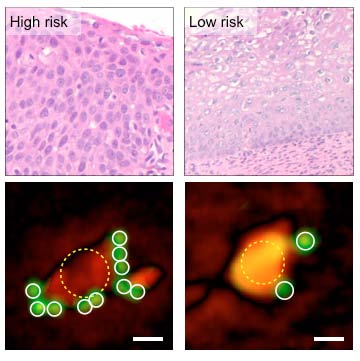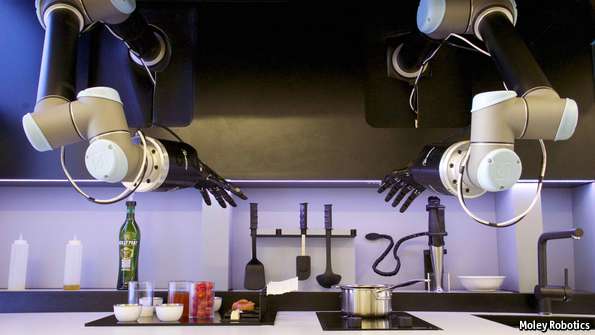
A device developed by MGH investigators may bring rapid, accurate molecular diagnosis of tumors and other diseases to locations lacking the latest medical technology
A device developed by Massachusetts General Hospital investigators may bring rapid, accurate molecular diagnosis of tumors and other diseases to locations lacking the latest medical technology. In their report appearing in PNAS Early Edition, the researchers describe a smartphone-based device that uses the kind of technology used to make holograms to collect detailed microscopic images for digital analysis of the molecular composition of cells and tissues.
“The global burden of cancer, limited access to prompt pathology services in many regions and emerging cell profiling technologies increase the need for low-cost, portable and rapid diagnostic approaches that can be delivered at the point of care,” says Cesar Castro, MD, of the MGH Cancer Center and Center for Systems Biology, co-lead author of the report. “The emerging genomic and biological data for various cancers, which can be essential to choosing the most appropriate therapy, supports the need for molecular profiling strategies that are more accessible to providers, clinical investigators and patients; and we believe the platform we have developed provides essential features at an extraordinary low cost.”
The device the team has developed – called the D3 (digital diffraction diagnosis) system – features an imaging module with a battery-powered LED light clipped onto a standard smartphone that records high-resolution imaging data with its camera. With a much greater field of view than traditional microscopy, the D3 system is capable of recording data on more than 100,000 cells from a blood or tissue sample in a single image. The data can then be transmitted for analysis to a remote graphic-processing server via a secure, encrypted cloud service, and the results rapidly returned to the point of care.
For molecular analysis of tumors, a sample of blood or tissue is labeled with microbeads that bind to known cancer-related molecules and loaded into the D3 imaging module. After the image is recorded and data transmitted to the server, the presence of specific molecules is detected by analyzing the diffraction patterns generated by the microbeads. The use of variously sized or coated beads may offer unique diffraction signatures to facilitate detection. A numerical algorithm developed by the research team for the D3 platform is capable of distinguishing cells from beads and of analyzing as much as 10 MB of data in less than nine hundredths of a second.
A pilot test of the system with cancer cell lines detected the presence of tumor proteins with an accuracy matching that of the current gold standard for molecular profiling, and the larger field of view enabled simultaneous analysis of more than 100,000 cells at a time. The investigators then conducted analysis of cervical biopsy samples from 25 women with abnormal PAP smears – samples collected along with those used for clinical diagnosis – using microbeads tagged with antibodies against three published markers of cervical cancer. Based on the number of antibody-tagged microbeads binding to cells, D3 analysis promptly and reliably categorized biopsy samples as high-risk, low-risk or benign, with results matching those of conventional pathologic analysis.
Read more: Smartphone-based device could provide rapid, low-cost molecular tumor diagnosis
The Latest on: Molecular tumor diagnosis
[google_news title=”” keyword=”Molecular tumor diagnosis” num_posts=”10″ blurb_length=”0″ show_thumb=”left”]
via Google News
The Latest on: Molecular tumor diagnosis
- Researchers find difference in pancreatic cancer cells, offering new hope for immunotherapy effectivenesson May 1, 2024 at 6:32 am
Pancreatic ductal adenocarcinoma (PDAC) is an aggressive cancer, and the diagnosis has dramatically increased over ... concept generating author for the article titled, "Comparative molecular ...
- Study highlights differences in pancreatic cancer cells based on locationon April 30, 2024 at 9:47 pm
A new study has found that pancreatic cancer cells are different based on their location in the pancreas, providing new information about tumors that could lead to better targeted treatments.
- Cancer Newson April 29, 2024 at 5:00 pm
It shows a cancer diagnosis and the time required for ... Liver Cancer: Molecular Signaling Pathway of Tumor Development Decoded Apr. 23, 2024 — As a malignant disease of the liver cells ...
- mRNA Is Promising A Breakthrough In Fighting Canceron April 29, 2024 at 9:02 am
When it comes to cancer, there’s innovation both on the diagnostics and the treatment front thanks to messenger RNA, or mRNA, a genetic material we all got acquainted with during the COVID-19 era as ...
- Precision medicine and how it will help with cancer treatments, rising costson April 28, 2024 at 8:55 pm
The approach dovetails perfectly with Singapore’s emerging focus on preventive health. Read more at straitstimes.com.
- How to Improve Radiotherapy Decisions in Endometrial Canceron April 25, 2024 at 8:26 am
Radiotherapy decisions should be made using refined genomic guidance, as recommended by 2021 updated international guidelines, to better identify patients with molecularly aggressive disease.
- RenovaroCube to Acquire 100% Ownership of Cyclomics, Reinforcing Cutting-Edge Cancer Diagnostics Partnershipon April 24, 2024 at 6:00 am
LOS ANGELES and AMSTERDAM, April 24, 2024 (GLOBE NEWSWIRE) -- . (Nasdaq: RENB), a trailblazer in AI-driven early cancer diagnostics and therapeutics, and Cyclomics, a leader in ultra-sensitive 4th ...
- Molecular You reports ‘breakthrough’ in early detection of pancreatic canceron April 22, 2024 at 4:59 pm
Molecular You Corp. said it has achieved a significant milestone in the early detection of pancreatic cancer. A case report, published in the journal OMICS, described the effectiveness of the ...
- As Molecular Testing Expands, Labs Find Reimbursement Process Becoming a Herculean Taskon April 22, 2024 at 7:50 am
Laboratories and lab consultants said that they have seen in recent years a more adversarial and uncertain reimbursement process fraught with delays, denials, and added labor.
- Next-generation breast cancer testing launchedon April 19, 2024 at 7:10 am
Detoxicare Molecular Diagnostics Laboratory forged a partnership deal with a global patient-focused biopharmaceutical company AstraZeneca for next-generation sequencing for breast cancer. The ...
via Bing News










